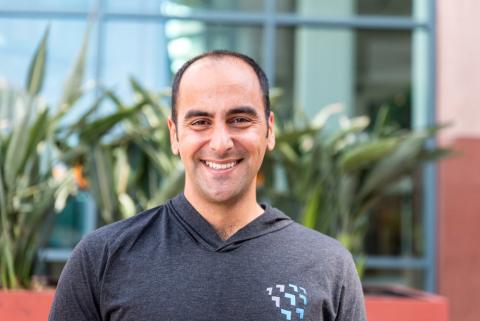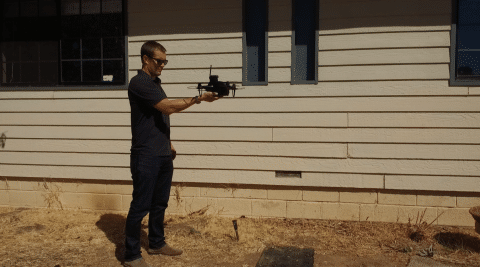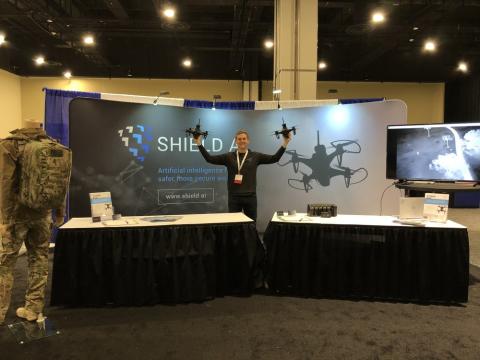[October 16, 2018]
On Machine Intelligence at Shield AI

What did you do before coming to Shield AI?
Before coming to Shield AI, I was an electrical engineer and programmer for the Unmanned Systems group at SPAWAR Systems Center, Pacific. Throughout my eleven years at SPAWAR, I worked on a variety of projects, including electrical design for ground vehicle payloads, command and control user interface development, autonomy stacks for ground vehicles, and GPS-denied navigation for surface vehicles. I was exposed to and worked in many different facets of robotics before realizing that my passion was in machine intelligence.
Why did you join Shield AI?
The biggest factor: Shield AI’s fast pace. I began here as a contractor, working at the office once a week for six months. During that time, I caught a unique glimpse of how quickly this company made strides toward creating a meaningful and impactful product. Every time I’d come in, I’d get a snapshot of what the rest of the team had accomplished the previous week, and it was mind-blowing. Flight would be noticeably smoother, exploration would be faster, we’d be able to detect and avoid a new type of obstacle; this team could accomplish in a week what would have taken most other group months or years. It was immediately clear that there was an amazing pool of top-notch talent at Shield AI.
It was also refreshing to find a team driven by such a clear mission. The team didn’t work so hard and so tirelessly simply for money; they worked that hard because they believed in what they were developing and knew it was critical for protecting our service members and innocent civilians. They wanted to make a difference. They didn’t measure success through a bureaucratic process, but through the impact they would make on their customers.
The decision to join was a no-brainer; I simply had to be a part of this amazing team.
What is most exciting to you about working on intelligence at Shield AI?
Intelligence is a rapidly advancing and ever-changing field of research, and we as a company fully embrace it as a key enabling technology in autonomy. The possibilities that machine intelligence provides are seemingly limitless, so the question at Shield AI has never been “is this possible?” but rather, “how do we make this possible?” This is what excites me–there is an answer to this question, and we don’t back away from the challenge of finding it.
I’m also excited that there’s absolutely no room for stagnation in this field. Working in intelligence, it’s imperative that we keep up with the latest cutting-edge technology. There is never a shortage of research papers in our backlog to read, and we make it a point to read through and discuss relevant papers, experiment with the latest hardware and software, and work to identify and address shortcomings in the state-of-the-art. We are constantly thinking about, learning about, and actively participating in building the future of an amazing technology.
What is the greatest challenge with developing intelligence technologies in this type of environment?
Though the field of intelligence is exciting and rewarding, it comes with a set of unique challenges.
Intelligence is a data-driven technology, and we can produce a LOT of data. So much so, in fact, that annotating, managing, sanitizing, and distributing it in a way that scales in both research and production settings requires thoroughly thought-out and well-executed infrastructure development. This in itself requires a team of dedicated engineers devoted to the task, and is far from a solved problem.
A lot of research in intelligence is directed toward exploring what the technology is capable of, and it is up to us to determine the feasibility and practicality of implementing these capabilities onto a product.
Reliability is of utmost importance in a system that’s intended to protect lives. Machine learning generally makes sense of data it has seen, and it is our job to work with the data to avoid bias toward any single environment and to make certain that the robot can understand and learn from new experiences. These are ongoing challenges that we continuously address well beyond the development and implementation of the learning algorithm itself.
How have you seen autonomy evolve in the last decade? What were the biggest challenges before and what are they now?
In my experience, computational power in embedded systems and fundamental advances in deep learning (starting with the advent of AlexNet) have been the key factors in evolving autonomy. What we once had to post-process off-board a system after a mission can now be done on-board and in real-time. Problems that were once extremely challenging, like pedestrian detection on-the-move, are now not only possible on modern embedded systems, but are available to the average robotics enthusiast as python libraries.
The challenges we face now aren’t necessarily new; their solutions are just finally within reach.









